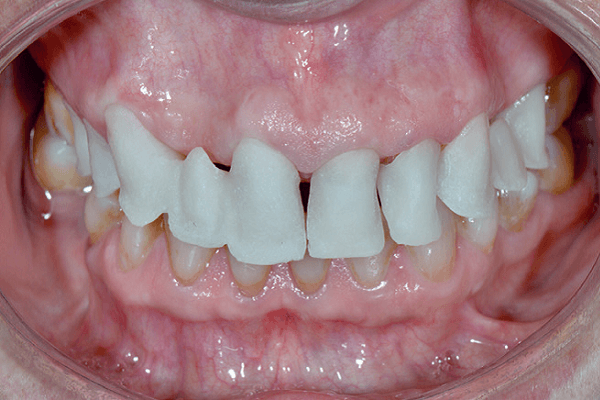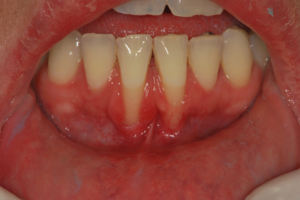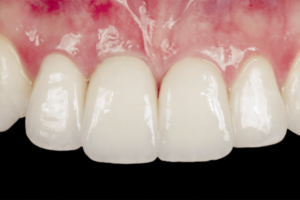RESUMO
A porcelana fundida ao metal (PFM) é o padrão-ouro para a reabilitação de pacientes com coroa total unitária e prótese parcial fixa (PPF). Ela tem boas propriedades mecânicas e biológicas, com taxas de sobrevivência muito altas. Esteticamente, elas não têm aparência natural. Em contrapartida, surgiram as porcelanas sem metal, com estética superior, mas com resistência inferior à das PFMs (porcelanas fundidas ao metal). No ano 2000, surgiu o dissilicato de lítio (LiO2), um material que combina excelente estética e resistência semelhante à do esmalte dentário (360 a 400 MPa). Nos últimos dez anos, os sistemas metalocerâmicos e livres de metal provaram ser eficazes para a fabricação de coroas e PPFs. O caso apresentado é de uma paciente com 58 anos de idade e alta exigência estética, parcialmente edêntula e apresentando próteses PFM antigas e deterioradas no setor anterior superior. O objetivo foi reabilitar estética e funcionalmente a paciente com coroas e PPFs em LiO2, aplicando uma técnica especial de processamento de LDS chamada “modified cut back”. Para isso, foi fabricada uma infraestrutura monolítica de LDS que cobre toda a parte oclusal, palatina e interproximal funcional dos dentes posteriores e anteriores, proporcionando resistência semelhante à das PFMs e excelente estética, através da aplicação de porcelana com camadas de nanofluorapatita em todo o lado vestibular.
Palavras-chave – Dissilicato de lítio; Próteses parciais fixas; Técnica cut back.
ABSTRACT
Porcelain fused to metal (PFM) is the gold standard, for rehabilitating patients with unitary full crown and fixed partial denture (FPDs). It has good mechanical and biological properties; with very high survival rates. Aesthetically they look unnatural. In contrast, metal-free porcelains appeared, with superior esthetics, but with lower resistance than PFMs. The year 2000 saw the appearance of lithium disilicate (LiO2), a material that combines excellent esthetics and resistance similar to dental enamel (360 to 400 MPa). In the last 10 years, metal-ceramic and metal-free systems have proven to be effective for the fabrication of crowns and FPDs. The case presented is a 58 years-old patient, with high esthetic demands, partially edentulous, with old and deteriorated PFM prosthesis in the upper anterior sector. Our objective is to esthetically and functionally rehabilitate our patient, with crowns and FPDs in LiO2, applying a special LDS processing technique that we call “modified cut back”. For this, we fabricate a monolithic LiO2 infrastructure that covers all the functional occlusal, palatal and interproximal part of the posterior and anterior teeth, giving similar resistance to PFM fixed prosthesis and excellent esthetics, through the application of nano fluorapatite layered porcelain in all the buccal aspects.
Key words – Lithium disilicate; Fixed partial dentures; Cut back technique.
Referências
- Pereira RM, Ribas RG, Montanheiro TLDA, Schatkoski VM, Rodrigues KF, Kito L et al. An engineering perspective of ceramics applied in dental reconstructions. J Appl Oral Sci 2023:31:e20220421.
- AlMashaan A, Aldakheel A. Survival of complete coverage tooth-retained fixed lithium disilicate prostheses: a systematic review. Medicina 2022 (Kaunas) 2022;59(1):95.
- Malament KA, Margvelashvili-Malament M, Natto ZS, Thompson V, Rekow D, ATT W. Comparison of 16.9-year survival of pressed acid etched e.max lithium disilicate glass-ceramic complete and partial coverage restorations in posterior teeth: performance and outcomes as a function of tooth position, age, sex, and thickness of ceramic material. J Prosthet Dent 2021;126(4):533-45.
- Malchiodi L, Zotti F, Moro T, De Santis D, Albanese M. Clinical and esthetical evaluation of 79 lithium disilicate multilayered anterior veneers with a medium follow-up of 3 years. Eur J Dent 2019;13(4):581-8.
- Willard A, Gabriel Chu TM. The science and application of IPS e.max dental ceramic. Kaohsiung J Med Sci 2018;34(4):238-42.
- Ivoclar Vivadent AG. Elaboración de las instrucciones de uso. IPS e.max Press [On-line]. Disponível em <https://ivodent.hu/__docs/878_83709869f4cf5658eb906db0348337c1.pdf>. Acesso em: 15-6-2023.
- Newaskar PS, Sonkesriya S, Singh R, Palekar U, Bagde H, Dhopte A. Evaluation and comparison of five-year survival of tooth-supported porcelain fused to metal and all-ceramic multiple unit fixed prostheses: a systematic review. Cureus 2022;14(10):e30338.
- Pieger S, Salman A, Bidra AS. Clinical outcomes of lithium disilicate single crowns and partial fixed dental prostheses: a systematic review. J Prosthet Dent 2014;112(1):22-30.
- Zhao K, Pan Y, Guess PC, Zhang XP, Swain MV. Influence of veneer application on fracture behavior of lithium-disilicate-based ceramic crowns. Dent Mater 2012;28(6):653-60.
- Alraheam IA, AL-Asmar A, Hasan N, Asoleihat F, Alkayed A. Clinical evaluation of cemented and adhesively resin-bonded monolithic and partially layered zirconia and lithium disilicate crowns. Saudi Dent J 2023;35(5):508-14.





